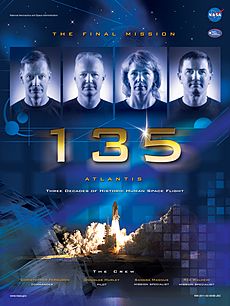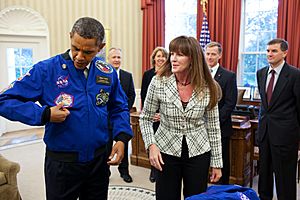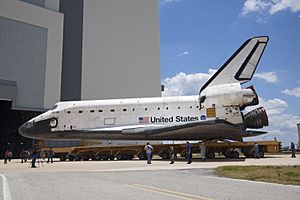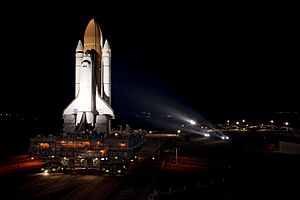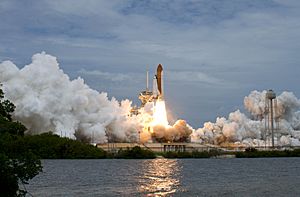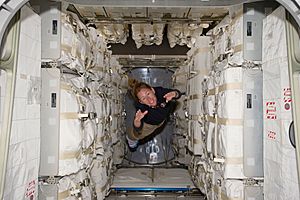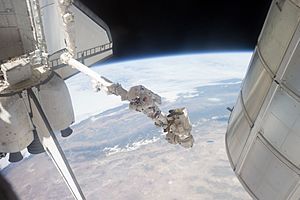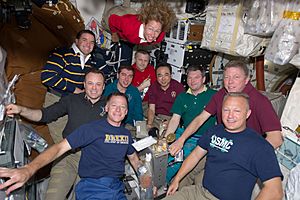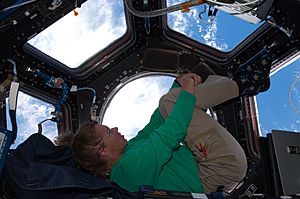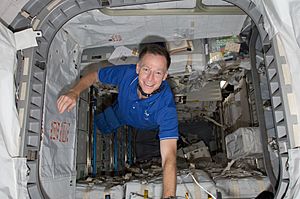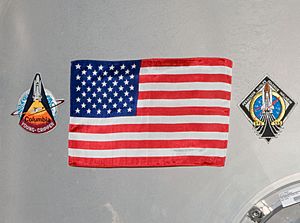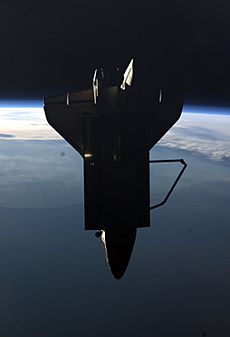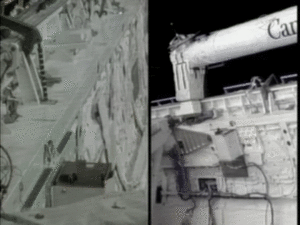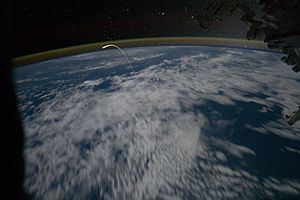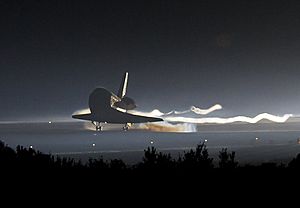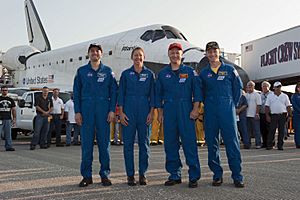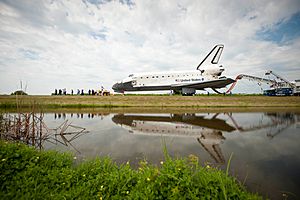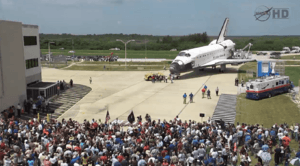STS-135 facts for kids
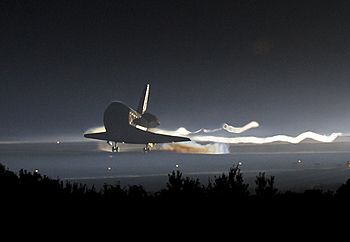
Atlantis lands at the Kennedy Space Center on July 21, 2011, bringing the Space Shuttle program to an end.
|
|
| Mission type | ISS logistics |
|---|---|
| Operator | NASA |
| Mission duration | 12 days, 18 hours, 28 minutes, 50 seconds |
| Distance travelled | 8,505,161 km (5,284,862 mi) |
| Spacecraft properties | |
| Spacecraft | Space Shuttle Atlantis |
| Crew | |
| Crew size | 4 |
| Members |
|
| Start of mission | |
| Launch date | 8 July 2011 15:29 UTC |
| Launch site | Kennedy, LC-39A |
| End of mission | |
| Landing date | 21 July 2011, 09:57 UTC |
| Landing site | Shuttle Landing Facility |
| Orbital parameters | |
| Reference system | Geocentric |
| Regime | Low Earth |
| Inclination | 51.6° |
| Docking with ISS | |
| Docking date | 10 July 2011 15:07 UTC |
| Undocking date | 19 July 2011 06:28 UTC |
| Time docked | 8 days, 15 hours, 21 minutes |
 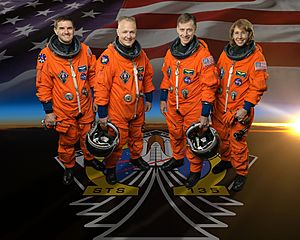 Pictured in the STS-135 crew portrait are NASA astronauts Chris Ferguson (center right), commander; Doug Hurley (center left), pilot; Rex Walheim and Sandy Magnus, both mission specialists. |
|
STS-135 was the 135th and final mission of the American Space Shuttle program. It used the Space Shuttle Atlantis. This mission launched on July 8, 2011, and landed on July 21, 2011. It was a special flight because it had the smallest crew of any shuttle mission since 1983, with only four astronauts.
The main job of STS-135 was to deliver important supplies to the International Space Station (ISS). The shuttle carried a large cargo module called Raffaello. This module was full of supplies for the astronauts living on the space station.
Even though it was a very important mission, there were questions about whether it would happen. This was because it didn't have money set aside in the NASA budget at first. However, NASA leaders decided that the mission was needed. They wanted to make sure the space station had enough supplies. This was especially important as new ways to send cargo to space were still being developed.
Finally, the mission was approved and funded. This allowed the training and preparations to go ahead. It was a big moment for NASA and space exploration.
Contents
- Meet the Crew
- Funding the Mission
- Mission Facts
- Important Milestones
- What Atlantis Carried
- Preparing the Shuttle
- Launch Day
- July 8 (Flight Day 1 – Launch)
- July 9 (Flight Day 2 – Heat Shield Check)
- July 10 (Flight Day 3 – Docking with ISS)
- July 11 (Flight Day 4 – MPLM Installation)
- July 12 (Flight Day 5 – Station Spacewalk)
- July 13 (Flight Day 6 – Cargo Transfers)
- July 14 (Flight Day 7 – Cargo Transfers/Rest)
- July 15 (Flight Day 8 – Cargo Transfers)
- July 16 (Flight Day 9 – Cargo Transfers)
- July 17 (Flight Day 10 – Cargo Transfers/Rest)
- July 18 (Flight Day 11 – MPLM Return, Farewells/Hatch Closure)
- July 19 (Flight Day 12 – Undocking)
- July 20 (Flight Day 13 – PicoSat Deployment/Landing Prep)
- July 21 (Flight Day 14 – Landing)
- Welcome Home Ceremonies
- Wake-Up Calls
- Images for kids
- See also
Meet the Crew

NASA announced the crew for STS-135 on September 14, 2010. Only four astronauts were chosen for this flight. Usually, shuttle missions had six or seven crew members. The reason for the smaller crew was important for safety. After this mission, the other shuttles, Discovery and Endeavour, would be retired. This meant there would be no other shuttle available for a rescue mission.
If Atlantis had been damaged in space, the crew would have moved to the International Space Station. They would then have returned to Earth one by one in Russian Soyuz capsules. To prepare for this, all STS-135 crew members were fitted for Russian Sokol space suits. They also had special seats molded for the Soyuz spacecraft.
Having a smaller crew also allowed the mission to carry more cargo to the ISS. This was the only time a Space Shuttle flew to the ISS with just four crew members. The last time a shuttle had only four crew members was 28 years earlier, on STS-6 in April 1983.
| Position | Astronaut | |
|---|---|---|
| Commander | Christopher Ferguson Third (last NASA) spaceflight |
|
| Pilot | Douglas Hurley Second spaceflight |
|
| Mission Specialist 1 | Sandra Magnus Third and last spaceflight |
|
| Mission Specialist 2 | Rex Walheim Third and last spaceflight |
|
Where the Crew Sat
| Seat | Launch | Landing | 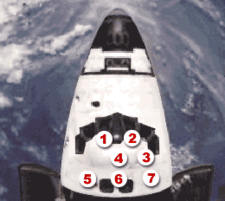 Seats 1–4 are on the Flight Deck. Seats 5–7 are on the Middeck. |
|---|---|---|---|
| S1 | Ferguson | Ferguson | |
| S2 | Hurley | Hurley | |
| S3 | Magnus | Magnus | |
| S4 | Walheim | Walheim |
Funding the Mission
The decision to fly STS-135 depended on whether lawmakers would provide the money. Both the House of Representatives and the Senate supported the idea. On July 15, 2010, a Senate committee voted to direct NASA to fly an extra Space Shuttle mission. This was STS-135.
On August 5, 2010, the Senate passed its bill. On September 29, 2010, the House of Representatives also approved the bill. The bill then went to President Barack Obama to sign into law.
On October 11, 2010, President Obama signed the law. This allowed NASA to plan for STS-135. However, it still needed specific funding. A typical shuttle mission cost about $450 million.
On January 20, 2011, STS-135 was officially named. On February 14, 2011, NASA announced that the mission would fly no matter what. This meant they were committed to the final flight. The federal budget approved in April 2011 included enough money for the mission. This ended all worries about funding STS-135.
Mission Facts
- Mass:
- Total liftoff weight: 4,521,143 pounds (2,050,756 kg)
- Orbiter liftoff weight: 266,090 pounds (120,700 kg)
- Orbiter landing weight: 226,375 pounds (102,682 kg)
- Payload weight: 28,418 pounds (12,890 kg)
- Inclination: 51.6°
- Period: 91 minutes
Important Milestones
This mission was special for many reasons:
- It was NASA's 166th crewed space flight.
- It was the 135th shuttle mission since STS-1.
- It was the 33rd and final flight of Atlantis.
- It was the 3rd shuttle flight in 2011.
- It was the 37th shuttle mission to the ISS.
- It was the 110th shuttle mission after the Challenger disaster.
- It was the 22nd shuttle mission after the Columbia disaster.
- It was the 100th launch during the day.
- It was the 133rd landing overall, and the 78th at Kennedy Space Center.
- It was the very last Space Shuttle Mission ever.
What Atlantis Carried
STS-135 carried supplies and equipment to the space station. These supplies were meant to last through 2012. This was because the Space Shuttle program was ending. Now, other programs like Commercial Orbital Transportation Services deliver supplies to the ISS.
Multi-Purpose Logistics Module (MPLM)
The Multi-Purpose Logistics Module (MPLM) named Raffaello was the biggest part of the cargo. This was Raffaello's fourth trip to the International Space Station. It was also the 12th time an MPLM was used. Unlike past missions that brought large parts for the station, STS-135 brought mostly bags and containers. The MPLM was packed with 16 racks of supplies, which was the most it could carry.
On the fourth day of the mission, Raffaello was moved out of Atlantis's cargo bay. Astronauts used the station's robotic arm, Canadarm2, to do this. It was then attached to the Harmony module of the ISS. After all the cargo was moved to the ISS, Raffaello was filled with almost 5,700 pounds (2,600 kg) of unneeded equipment and trash. This was brought back to Earth. On the eleventh day, the MPLM was detached from Harmony and put back into the shuttle's cargo bay.
Lightweight Multi-Purpose Carrier (LMC)
The Lightweight Multi-Purpose Carrier (LMC) was also on STS-135. It carried a broken pump module from the station's cooling system. This pump was brought back to Earth for engineers to study why it failed. The LMC also carried the Robotic Refueling Mission (RRM) experiment.
Robotic Refueling Mission (RRM)
Atlantis carried the Robotic Refueling Mission (RRM). This experiment was designed to show how robots could refuel satellites in space. The goal was to develop technology that could be used by companies in the future.
The RRM had four tools, cameras, lights, pumps, and electrical systems. It was prepared at the Kennedy Space Center. Once on the ISS, the RRM was installed. The Dextre robot was planned to be used for the refueling experiments.
Picosatellite Solar Cell Testbed 2 (PSSC-2)
Space Shuttle Atlantis also carried a tiny satellite called PSSC-2. This satellite was successfully released from the shuttle's cargo bay on the 13th day of the flight. It was the 180th and last payload ever released by a Space Shuttle.
TriDAR Sensor
The mission also included the third flight of the TriDAR sensor. This was a special 3D laser camera. It was designed to help spacecraft find and dock with other objects in space automatically. It could also help with planetary landings and guiding robotic rovers. TriDAR had flown on previous shuttle missions. On STS-135, it was used to test how well it could help with automatic docking in orbit.
Cargo Brought Back to Earth
STS-135 brought several items back to Earth. The broken ammonia pump module was returned inside Atlantis's cargo bay. A faulty air assembly part was also brought back in the MPLM. The shuttle also carried back experiments and other materials in its middeck lockers. Since there were only four crew members, there was extra space in the middeck for more cargo.
Other Supplies
Astronauts used an iPhone to record experiments. This phone was left on the ISS for future use. Two Nexus S smartphones were also installed inside Synchronized Position Hold, Engage, Reorient, Experimental Satellites (SPHERES). These allowed the crew to control small robots on the ISS.
Preparing the Shuttle
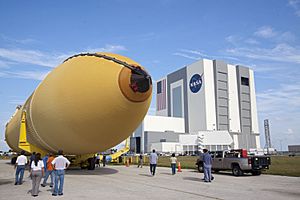
The large External Tank 138 (ET-138) arrived at the Kennedy Space Center on July 14, 2010. It was then moved into the Vehicle Assembly Building (VAB).
NASA had planned to use a different tank, ET-122, for a rescue mission. But ET-122 had been damaged during Hurricane Katrina. Even though it was repaired, NASA decided to use the newer ET-138 for Atlantis's final flight. This was a safety measure.
In December 2010, technicians installed the main engines on Atlantis. This was the last time main engines would be installed on a Space Shuttle.
The Solid Rocket Boosters (SRBs) were stacked starting on March 29, 2011. The boosters were a mix of old and new parts. For example, a part of the left booster had flown on STS-1, the first flight of Space Shuttle Columbia. The ET-138 was attached to the SRBs on April 25.
President Obama's Family Visits
President Barack Obama, his wife Michelle Obama, and their daughters, Malia and Sasha, visited Atlantis. They saw the shuttle at the Orbiter Processing Facility (OPF-1) on April 29, 2011. They learned about the shuttle from a NASA technician and an astronaut.
Moving Atlantis to the VAB
On May 17, 2011, Atlantis left OPF-1 and moved to the VAB. This was for it to be attached to the external tank and boosters. The trip was slow, allowing workers to take photos with the shuttle. The four STS-135 astronauts were also there to greet the workers.
Inside the VAB, Atlantis was lifted and turned upright on May 18. It was then lowered and connected to the external tank and solid rocket boosters. This was finished on May 19. On the same day, NASA announced July 8, 2011, as the launch date for STS-135.
Rollout to the Launch Pad
Atlantis was rolled out to Launch Pad 39A on June 1. The move started on May 31, 2011. After a 3.4-mile (5.5 km) journey, the shuttle was secured on the launch pad.
Many people, including NASA families, watched the rollout. The STS-135 crew was also there to see the last-ever rollout of a Space Shuttle. They answered questions from the news. While Atlantis was moving, Endeavour was landing nearby after its final mission, STS-134.
Fueling Test
Atlantiss external tank was filled with fuel on June 15, 2011. This was to check if it was working correctly. During the test, a small hydrogen fuel leak was found in one of Atlantiss main engines. The leaking part was replaced on June 21.
Engineers also checked the tank for cracks. They used X-rays to make sure everything was safe. They found no problems after analyzing the results.
Payload Installation
The STS-135 payload was moved to Launch Pad 39A on June 16. It was lifted into the cleanroom the next day. The payload bay doors of Atlantis were opened on June 18. The cargo was installed into the shuttle's payload bay on June 20.
Countdown Rehearsal
The STS-135 crew arrived at Kennedy Space Center on June 20. They took part in a countdown rehearsal and emergency training. The four astronauts spoke to reporters. Commander Chris Ferguson said they were "incredibly proud to represent the final flight." During training, the crew practiced evacuating the launch pad. They also boarded Atlantis for a full countdown simulation on June 23.
Launch Day
| Attempt | Planned | Result | Turnaround | Reason | Decision point | Weather go (%) | Notes |
|---|---|---|---|---|---|---|---|
| 1 | 8 Jul 2011, 11:29:04 am | Success | — | initially 30%, later 60% | Initial weather reports indicated concerns for clouds, thunderstorms and lightning in the area. Countdown was held at 31 seconds to verify gaseous oxygen vent arm had fully retracted. Launch time 11:29:04 |
July 8 (Flight Day 1 – Launch)
The weather on launch day was uncertain, with only a 30% chance of launching. But an hour before launch, it improved to 60%. Launch director Mike Leinbach gave the final "go" for launch. He wished the crew good luck on "the final flight of this true American icon." Commander Chris Ferguson replied, "The Shuttle will always be a reflection of what a great nation can do."
At 31 seconds before launch, the countdown stopped. This was because a part called the Gaseous Oxygen Vent Arm didn't show it had moved back. The team quickly checked it with a camera. The countdown then restarted after about two minutes.
The final flight of Space Shuttle Atlantis launched from the Kennedy Space Center on July 8 at 11:29:03.9 EDT. The launch was watched by nearly a million people. The flight went as planned. The two boosters separated after two minutes. The main engines shut off after about 8 minutes and 24 seconds. The external tank separated shortly after. A camera on the external tank sent back video of it breaking apart in the atmosphere.
The crew then made several small adjustments to Atlantis's path. They opened the shuttle's cargo bay doors. They also checked the Ku-band antenna. Mission control reported that there were no signs of damage during the launch. Commander Ferguson and Pilot Hurley also checked the shuttle's robotic arm.
July 9 (Flight Day 2 – Heat Shield Check)
The crew started their day with a special "good morning" message from NASA's Marshall Space Flight Center. The main goal for the day was to check Atlantis's heat shield. This was to look for any damage from the launch. Commander Ferguson, Pilot Hurley, and Mission Specialist Magnus used the shuttle's robotic arm. They also used the Orbiter Boom Sensor System (OBSS). This system has cameras and laser sensors. They scanned the wings and the nose cap of the shuttle. The information was sent to experts on the ground to review. The heat shield survey took about five hours. The crew worked very efficiently.
While the heat shield check was happening, Mission Specialist Walheim prepared items on the shuttle's middeck. These items would be moved to the space station. Walheim and Hurley also checked the tools for docking with the ISS. Ferguson and Magnus set up a camera to help align Atlantis with the space station.
The shuttle also made more small path adjustments to get closer to the ISS. On the ISS, the Expedition 28 crew prepared for the shuttle's arrival. They also discussed how to photograph Atlantis as it approached. Flight director Kwatsi Alibaruho said that Atlantis's mission had one of the smoothest starts ever.
July 10 (Flight Day 3 – Docking with ISS)
The STS-135 crew began their day preparing to dock with the ISS. They had a small computer issue, but it didn't affect the docking.
Commander Chris Ferguson and pilot Douglas Hurley guided Atlantis closer to the ISS. They performed several engine burns to match orbits. When Atlantis was about 600 feet (180 meters) below the ISS, Ferguson performed a 360-degree flip. This is called the rendezvous pitch maneuver (RPM). During this flip, three ISS crew members took photos of Atlantis's underside. This was part of the heat shield inspection. The photos were sent to mission control to check for any damage.
Atlantis docked with the ISS at 15:07 UTC. This happened as the two spacecraft orbited 220 miles (350 km) over the South Pacific Ocean. This was Atlantis's 19th time docking with a space station. Pilot Hurley confirmed the successful docking. Astronaut Ron Garan welcomed them, saying, "Welcome to the International Space Station for the last time." After checking for leaks, the hatches were opened. The shuttle crew floated into the station's Harmony module. They received a safety briefing from the station crew.
The crew then started working. Ferguson and Hurley used the shuttle arm to hand over the OBSS to the station's robotic arm. This was in case more heat shield checks were needed. Magnus set up TV equipment, and Walheim moved spacewalk gear.
Flight controllers also watched for a piece of space debris. It was from a Russian satellite. They checked if it would come too close to the station and shuttle. They found that no maneuver was needed.
-
Atlantis over the Bahamas.
July 11 (Flight Day 4 – MPLM Installation)
The main goal of Flight Day 4 was to attach the Raffaello MPLM to the station. The crew started their day with the song "Tubthumping" by Chumbawamba. Mission Specialist Sandra Magnus and Pilot Doug Hurley used the Canadarm2. They removed the Raffaello module from Atlantis's cargo bay. They then attached it to the Harmony node of the ISS. After checking for leaks, the hatches to Raffaello were opened.
Because Atlantis launched on time and saved power, NASA approved a one-day mission extension. This allowed the crew more time to transfer cargo. Mission control also decided not to do a detailed inspection of Atlantis's heat shield. Experts found only minor damage.
Before their workday ended, the STS-135 crew and some Expedition 28 crew members met. They reviewed the plans for the next day's spacewalk.
July 12 (Flight Day 5 – Station Spacewalk)
Flight day 5 featured a spacewalk by Expedition 28 Flight Engineers Mike Fossum and Ron Garan. The main tasks were to bring a broken pump module back to Earth. They also installed two experiments and repaired a base for the station's robotic arm. The spacewalk began at 13:22 UTC. Fossum's spacesuit had red stripes for identification.
The spacewalkers used Canadarm2 to get the broken pump module. Pilot Hurley and Mission Specialist Magnus operated the arm from inside the station. Garan rode the arm to the pump module. He and Fossum removed it. Garan then took the pump module into Atlantis's cargo bay. Fossum bolted it into place.
Next, the astronauts removed the Robotic Refueling Mission (RRM) experiment. Fossum carried it to a platform for temporary storage. Garan cleaned up tools in Atlantis's cargo bay. Mission Specialist Rex Walheim, who helped coordinate the spacewalk, told Garan, "You're the last EVA person in the payload bay of a shuttle."
Fossum then fixed a stuck wire on the Zarya module. This part helps the Canadarm2 move on the Russian side of the ISS. Garan also set up a materials experiment (MISSE-8). This experiment tests materials in space. Finally, Fossum and Garan installed an insulating cover on the Tranquility node.
The spacewalk lasted six hours and 31 minutes. It was the 160th spacewalk for ISS assembly and maintenance. Inside the complex, cargo transfer from the Raffaello MPLM began.
July 13 (Flight Day 6 – Cargo Transfers)

The Atlantis crew received a special wakeup message from Sir Elton John. The crew focused on unpacking supplies from the Raffaello MPLM. They had already transferred 26% of the 15,069 pounds of cargo. The MPLM launched with 9,403 pounds of cargo. It was expected to return 5,666 pounds when Atlantis landed. These supplies were meant to keep the station well-stocked through 2012.
The station crew also helped with the cargo transfers. Crew members opened the Pressurized Mating Adapter (PMA-3). They stored some material from Raffaello there. About 50% of the cargo had been moved.
All four shuttle crew members took time to talk with reporters. They spoke to news channels from New York and San Francisco.
On Flight Day 6, Space Shuttle Discovery was moved into storage. This was to make space for Atlantis in the Orbiter Processing Facility after it landed.
July 14 (Flight Day 7 – Cargo Transfers/Rest)
Flight Day 7 saw the crew unpacking more cargo from the Raffaello MPLM.
The crew also had some special events. Commander Ferguson and Mission Specialist Magnus spoke with reporters. Later, the entire crew was interviewed by other news channels. Afterward, the shuttle crew had most of the afternoon off. For dinner, both the Atlantis and station crews enjoyed a special "All-American Meal." It included barbecue brisket or grilled chicken and apple pie.
NASA also released a video from cameras on Atlantis's solid rocket boosters. It showed the shuttle's launch.
The astronauts were woken up by a master alarm on Atlantis. This alarm meant one of Atlantis's computers (GPC-4) had failed. Commander Ferguson went to check the issue. With help from ground control, he moved the computer's programs to another computer (GPC-2). The transfer took about 45 minutes. After fixing the issue, Ferguson and the crew went back to sleep. Mission control extended their sleep time by 30 minutes.
July 15 (Flight Day 8 – Cargo Transfers)
The crew woke up to a special message and song from Sir Paul McCartney. Commander Ferguson and pilot Hurley successfully restarted the GPC-4 computer. Flight controllers in Houston watched the computer to make sure it was working normally.
While the commanders worked on the computer, Mission Specialists Magnus and Walheim continued cargo transfers. They worked with the station crew. Walheim also moved spacewalking gear to Atlantis. Some of this gear would be left on the station for future spacewalks.
Several media interviews took place. Ferguson and Hurley spoke with news agencies. All STS-135 crew members then talked with other reporters. At a news conference, Atlantis crew members and their station colleagues answered questions.
President Barack Obama also called the combined crews. He thanked everyone who supported the shuttle program. He said he was proud of all the crew members. Commander Ferguson said they were honored to represent their countries. Station Flight Engineer Sergei Volkov called the crews "one big family."
The STS-135 lead flight director, Kwatsi Alibaruho, said cargo transfers were 70% complete. He also mentioned a broken latch on Atlantis's middeck locker. This locker held canisters that remove carbon dioxide from the air. The problem was fixed. Alibaruho said the GPC-4 failure was rare.
July 16 (Flight Day 9 – Cargo Transfers)
Flight day 9 was an extra day added to the mission. This was because Atlantis had saved enough fuel for its power systems. The four crew members spent more time moving supplies between the ISS and the Raffaello MPLM.
Commander Ferguson and Pilot Hurley successfully repaired the door to the carbon dioxide removal canisters. Mission Specialist Magnus took air samples in the space station. These samples would be studied later. Magnus also worked with the Japanese robotic arm. Mission Specialist Walheim and station crew member Mike Fossum continued working with spacewalking equipment. Some of this equipment would stay on the station. Hurley and station crew member Ron Garan stored cargo in Atlantis's middeck to be returned to Earth. The mid-deck was expected to be full of cargo on the way back.
The STS-135 crew also recorded a message. It was a tribute to Atlantis and the Space Shuttle Program. Ferguson spoke about a U.S. flag behind them. This flag had flown on the first Space Shuttle mission, STS-1. It was given to the space station crew. The flag would stay on the station until the next U.S. crew launched to the International Space Station retrieved it. This happened on June 1, 2020.
In another video, Ferguson and Hurley honored U.S. naval aviators. They mentioned famous astronauts like Alan Shepard, John Glenn, Neil Armstrong, and Eugene Cernan. They also mentioned John Young and Robert Crippen, the first shuttle pilots.
Before bed, mission control told the crew that the GPC-4 failure was likely caused by a single event upset. This is a temporary computer glitch. They said GPC-4 was healthy. They planned to use it for undocking the next morning.
July 17 (Flight Day 10 – Cargo Transfers/Rest)
On Flight Day 10, the Atlantis crew finished moving cargo inside the Raffaello MPLM. Space Station flight director Chris Edelen said that Raffaello was packed with all the cargo to be returned to Earth. STS-135 delivered 9,403 pounds (4,265 kg) of cargo to the station. The crew packed 5,666 pounds (2,570 kg) of cargo to bring back. The crew also installed parts to release the MPLM from the station.
Pilot Doug Hurley and Mission Specialist Rex Walheim answered questions from students. This was the last educational event by a Space Shuttle crew.
After lunch, Mission Specialist Sandra Magnus and Commander Chris Ferguson moved experiments and equipment to and from Atlantis's middeck. They completed 84% of the middeck transfers. They moved a new science refrigerator to the station. They also brought back a broken mass spectrometer and a faulty gyroscope.
NASA TV showed a video of Magnus and Station Flight Engineer Satoshi Furukawa cheering for their countries' women's soccer teams. The U.S. team played against Japan in the 2011 FIFA Women's World Cup final. Japan won the game.
July 18 (Flight Day 11 – MPLM Return, Farewells/Hatch Closure)
The STS-135 crew returned the MPLM to Atlantis's cargo bay on flight day 11. They then closed the hatches between the Space Station and the Shuttle. They prepared for undocking the next day.
The hatches separating Raffaello MPLM and the ISS were closed. With the station's Canadarm2 holding Raffaello, commands were sent to release it. Mission Specialist Magnus and Pilot Hurley operated the arm. They un-berthed Raffaello and moved it back to Atlantis's cargo bay. This was the 10th and final time an MPLM was transferred in the Space Shuttle program.
Atlantis and Space Station crew members said their goodbyes. They closed the hatches between the two spacecraft at 14:28 UTC. This ended seven days, 21 hours, and 41 minutes of being docked together.
At the farewell ceremony, Commander Ferguson gave the station a small U.S. flag. This flag had flown on STS-1, the first Space Shuttle mission. He also gave them a shuttle model signed by program officials. Ferguson thanked the station commander for their hospitality. The station commander wished the shuttle crew a safe trip home.
After the crew returned to Atlantis, they prepared for undocking. Ferguson and Hurley installed a camera. Hurley and Walheim checked the docking tools.
July 19 (Flight Day 12 – Undocking)
Space Shuttle Atlantis undocked from the Space Station early on flight day 12. This marked the end of shuttle visits to the orbiting outpost. Pilot Douglas Hurley controlled the undocking. It happened at 6:28 UTC over the Pacific Ocean. Astronaut Ron Garan rang the station's bell. He said, "Atlantis, departing the International Space Station for the last time."
After undocking, Atlantis moved away. It stopped about 600 feet (180 meters) ahead of the ISS. Pilot Doug Hurley paused the shuttle. During this time, the space station rotated 90 degrees. This gave the Atlantis crew a good chance to take photos and videos of the station. These images would help experts on the ground. The fly-around took about 25 minutes.
Teams in both shuttle and station mission control rooms in Houston were working their last shuttle shift. Commander Ferguson thanked the shuttle flight controllers. He told them to "make a memory." From the station control room, astronaut Daniel Tani said it was "a pleasure and an honor" to support the mission. He noted that the ISS wouldn't be there without the shuttle. Ferguson replied that it had been "an incredible ride."
After the fly-around, Atlantis fired its engines twice to move away from the space station.
After lunch, Ferguson, Hurley, and Mission Specialist Sandra Magnus did a final check of Atlantis's heat shield. They used the shuttle's robotic arm and the OBSS. They looked at the wing edges and nose cap. The crew finished the inspections. Magnus and ground engineers reviewed the data. They checked for any damage from micrometeoroids or space junk. The crew went to bed after a successful day.
July 20 (Flight Day 13 – PicoSat Deployment/Landing Prep)
One more satellite takes its place in the sky,
The last of many that the shuttle let fly.
Magellan, Galileo, Hubble, and more,
Have sailed beyond her payload bay doors.
There've filled science books, and still more to come,
The shuttle's legacy will live on when her flying is done.
We wish PicoSat success in space where it roams,
It can stay up here, but we're going home.
Yes soon for the last time we'll gently touch down,
Then celebrate the shuttle with our friends on the ground.
Flight day 13 was the last full day in space for the STS-135 crew. They checked Atlantis's flight controls. They also fired its small jets to make sure everything was ready for landing. Mission managers cleared Atlantis for re-entry. This was after reviewing the heat shield inspection results.
Atlantis's crew also released a small satellite called PSSC-2. It was an 8.2-pound (3.7-kg) technology experiment. It was deployed from the shuttle's cargo bay. The picosatellite would send back data on its solar cells. PSSC-2 was the 180th and final payload deployed by a Space Shuttle. Mission specialist Rex Walheim marked the moment by reciting a poem.
The crew also did one last round of interviews with reporters.
Later, the crew finished preparing for Atlantis's landing. Commander Ferguson and Pilot Hurley practiced landing procedures using a simulator. They also checked the shuttle's flight control surfaces. They then put away the Ku-Band antenna and went to sleep.
The Empire State Building in New York City honored the Space Shuttle program. It lit up in red, white, and blue on the night of July 20.
July 21 (Flight Day 14 – Landing)
The final day began with the wakeup song "God Bless America". This song was for the crew and everyone who worked on the shuttle program.
The weather for landing looked good. Flight controllers decided not to delay the landing until daylight. The crew started "fluid loading." This means drinking a lot of liquids and salt tablets. This helps astronauts adjust to Earth's gravity after being in space.
The de-orbit burn happened at 4:49:04 a.m. EDT. It lasted for three minutes and 17 seconds. This slowed the shuttle down over the Indian Ocean. The shuttle then entered Earth's atmosphere around 5:25 a.m. EDT.
The Space Shuttle landed at the Kennedy Space Center on runway 15 at 5:57:00 am EDT. The nose gear touched down at 5:57:20 am EDT. The wheels stopped at 5:57:54 am EDT.
Mission Commentator Rob Navias announced the landing. He said, "The shuttle pulls into port for the last time. Its voyage, at an end." Commander Chris Ferguson said, "Mission complete, Houston. After serving the world for over 30 years, the shuttle has earned its place in history." Entry CAPCOM Barry Wilmore replied, "Job well done America!" Ferguson added, "The Space Shuttle changed the way we viewed the world. America's not gonna stop exploring. Thank you Columbia, Challenger, Discovery, Endeavour and our ship Atlantis. Thank you for protecting us."
Hundreds of people watched the last landing at Kennedy Space Center. About 4,000 shuttle program workers watched TV coverage in Texas. In Mission Control, team members celebrated.
After powering down the shuttle, the crew left Atlantis. They did the traditional walk-around of the shuttle. They met NASA leaders and officials. Commander Ferguson noted that a door in the shuttle's mid-deck opened during entry. After a short speech, the crew went to rest.
Atlantis was then towed back to the Orbiter Processing Facility (OPF-2). There, NASA employees had a walk-around. Atlantis would then be prepared for its retirement as a museum exhibit.
Welcome Home Ceremonies
On July 21, 2011, NASA held an event for employees outside OPF-2. Atlantis was parked there. NASA leaders spoke to the shuttle program employees. Two women, Rita Wilcoxson and Patricia Stratton, received high NASA honors. They were recognized for their leadership in the Space Shuttle program. A public "welcome home" ceremony for the crew was held in Houston on July 22.
Wake-Up Calls
NASA started a tradition of playing music for astronauts during the Gemini program. The first time music was used to wake up a crew was during Apollo 15. Each song is chosen carefully, often by the astronauts' families. The songs usually have a special meaning to a crew member or relate to their daily tasks.
For STS-135, some wake-up calls included greetings from the artists or NASA employees.
| Flight Day | Song | Artist | Greeting | Played for | Links |
|---|---|---|---|---|---|
| Day 2 | "Viva la Vida" | Coldplay | Employees at the Marshall Space Flight Center | Douglas Hurley | MP3 WAV Video |
| Day 3 | "Mr. Blue Sky" | Electric Light Orchestra | Christopher Ferguson | MP3 WAV Video | |
| Day 4 | "Tubthumping" | Chumbawamba | Sandra Magnus | MP3 WAV Video | |
| Day 5 | "More" | Matthew West | Rex Walheim | MP3 WAV Video | |
| Day 6 | "Rocket Man" | Elton John | Elton John | STS-135 Crew | MP3 WAV Video |
| Day 7 | "Man on the Moon" (A cappella version) | Michael Stipe | Michael Stipe | STS-135 Crew | MP3 WAV Video |
| Day 8 | "Good Day Sunshine" | The Beatles | Paul McCartney | STS-135 Crew | Video |
| Day 9 | "Run the World (Girls)" | Beyoncé Knowles | Beyoncé Knowles | Sandra Magnus | Video |
| Day 10 | "Celebration" | Kool & the Gang | Employees at the Stennis Space Center | Sandra Magnus | WAV Video |
| Day 11 | "Days Go By" | Keith Urban | Employees at the Johnson Space Center | Rex Walheim | Video |
| Day 12 | "Don't Panic" | Coldplay | Douglas Hurley | Video | |
| Day 13 | "Fanfare for the Common Man" | Aaron Copland | Employees at the Kennedy Space Center | Christopher Ferguson | Video |
| Day 14 | "God Bless America" | Kate Smith | Shannon Lucid on behalf of all previous missions and to the people that made them happen | STS-135 Crew and "for all the men and women who put their hearts and souls into the Shuttle program for all these years" | Video |
Images for kids
-
Aurora Australis and a number of stars are visible as the Atlantis-Station complex passes over the southern hemisphere.
See also
 In Spanish: STS-135 para niños
In Spanish: STS-135 para niños


